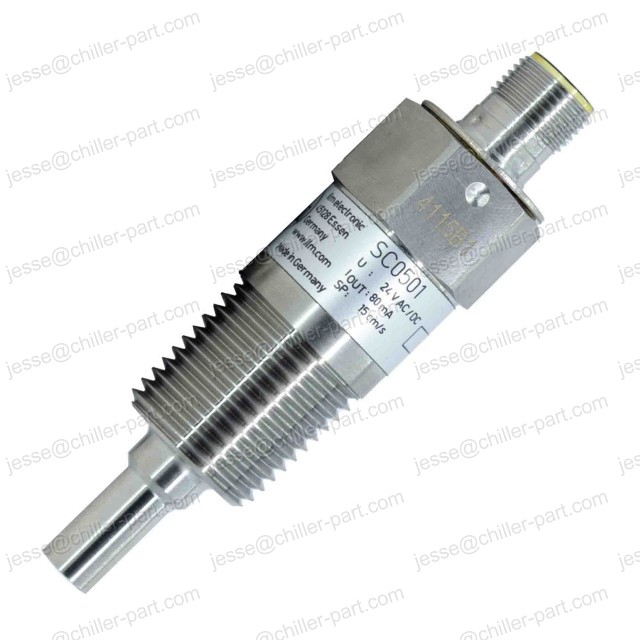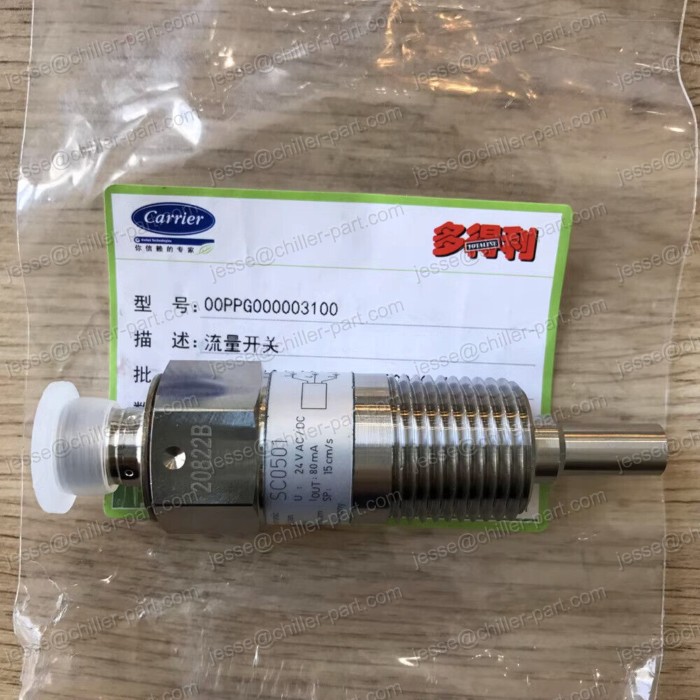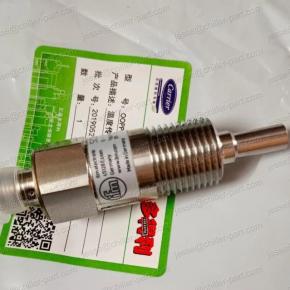Carrier flow switch OOPPG00003100A SC0501 for Carrier Chillers 30RB
Carrier flow switch OOPPG00003100A SC0501 for Carrier Chillers 30RB
Product Description

In chiller units, a flow switch is an essential component used to monitor the flow of chilled water through the system. It serves several critical functions:
Flow Monitoring: The primary function of a flow switch in a chiller unit is to monitor the flow of chilled water circulating within the system. It ensures that there is a consistent and adequate flow of water to facilitate the heat exchange process in the evaporator and maintain efficient cooling operation.
Protection: Flow switches help protect the chiller unit from potential damage by detecting insufficient flow or loss of flow. If the flow of chilled water drops below a specified threshold, the flow switch can trigger an alarm, shut down the chiller unit, or activate other protective measures to prevent equipment damage due to overheating.
Efficiency Optimization: Maintaining proper flow rates is crucial for optimizing the efficiency of the chiller unit. Flow switches help ensure that the chiller operates within its designed flow range, maximizing energy efficiency and cooling capacity while minimizing operating costs.
Safety: Flow switches contribute to the safety of the chiller system by detecting abnormal flow conditions that could indicate issues such as pump failure, blocked pipes, or airlocks. By promptly detecting these conditions, flow switches help prevent potential safety hazards and equipment malfunctions.
Flow switches in chiller units are typically installed in the piping system connected to the chiller's evaporator and/or condenser. They are positioned to sense the flow of chilled water entering or exiting these components. When the flow rate falls below or exceeds a predetermined setpoint, the flow switch activates a switch mechanism, signaling the control system to take appropriate action.

Proper selection, installation, and maintenance of flow switches are essential to ensure their reliable operation and the overall performance of the chiller unit. This includes regularly checking for proper flow switch function, verifying calibration, and ensuring that the flow switch is free from debris or obstructions that could impair its operation. Additionally, flow switches should be selected based on the specific requirements of the chiller system, including factors such as flow rate, pressure, temperature, and compatibility with the circulating fluid.
Packaging & Shipping
Goods will be carefully wrapped and placed into a neutral carton, or packaged according to your specific requirements for added customization and satisfaction.

Our Services
We specialize in supplying high-quality chiller parts worldwide, ensuring optimal performance and customer satisfaction.Moreover,We are a leading factory specializing in the production of high-quality oil filters for medium and low-temperature chiller units, chiller units, and various HVACR parts.
For inquiry:
Part Name/Number/image
Quantity Required
Technical Specifications (if applicable)
Any Preferred Brands or Specifications
No. | descprition | product |
1 |
filter | oil filter element |
2 | filter drier | |
3 | suction filter | |
4 | oil seperation filter | |
5 |
sensor | temperature sensor |
6 | pressure sensor | |
7 | low pressure tranducer | |
8 | oil level sensor | |
9 | liquid level sensor | |
10 |
switch | oil pressure switch |
11 | high voltage switch | |
12 | low voltage switch | |
13 | temperature switch | |
14 | water flow switch | |
15 | oil flow switch | |
16 | electronic flow switch | |
17 |
valve | electronic expansion valve |
18 | globe valve/sperical valve | |
19 | one-way valve | |
20 | solonoid valve | |
21 | bypass valve | |
22 | safety valve | |
23 | angle valve | |
24 | butterfly valve | |
25 | connector | sensor connector |
26 | flow switch connector | |
27 |
relay | relay |
28 | starting relay | |
29 | overload protection replay | |
30 |
board | motherboard/mainboard |
31 | compressor protection board | |
32 | power board | |
33 | display screen | |
34 | PC board | |
35 | control board | |
36 | ISM board | |
37 | Compressor Frequency Conversion Board | |
38 |
module | ICVC module |
39 | guide vane motor | |
40 | star wheel | |
41 | electronic expansion module | |
42 |
compressor | compressor |
43 | scew compressor | |
44 | centrifugal compressor | |
45 |
others | condenser |
46 | evaporator | |
47 | pressure gage | |
48 | protection switch | |
49 | thrust probe assembly | |
50 | piston assembly | |
51 | impeller | |
52 | shaft seal | |
53 | O-ring | |
54 | bearing | |
55 | seal kit | |
56 | oil pump | |
57 | oil heater | |
58 | oil cooler | |
59 | power box | |
60 | control cabinet |
FAQ
Q:What are the common parts needed for chiller maintenance?
A:Common chiller parts include compressors, condenser and evaporator coils, expansion valves, control panels, motors, fans, sensors, and refrigerant components like filters, driers, and valves.
Q:Where can I source chiller parts?
Chiller parts can be sourced from various suppliers including OEM (Original Equipment Manufacturer) dealers, authorized distributors, HVAC/R (Heating, Ventilation, Air Conditioning, and Refrigeration) supply stores, online marketplaces, and specialized industrial parts suppliers.
Q:How do I ensure compatibility when purchasing chiller parts?
It's crucial to match the specifications and compatibility requirements of the original part. Refer to the chiller's model number, serial number, and specifications provided by the manufacturer. Consulting with a qualified technician or engineer can also help ensure compatibility.
Q:Are OEM parts necessary, or are aftermarket parts suitable?
OEM parts are specifically designed for the chiller model and are generally recommended for optimal performance and compatibility. However, aftermarket parts can be a more cost-effective alternative, provided they meet the required specifications and quality standards.
Q:What factors should I consider when choosing a supplier for chiller parts?
Consider factors such as the supplier's reputation, reliability, warranty offerings, pricing, shipping options, and customer service. Choose suppliers with a track record of providing genuine, high-quality parts and responsive support.
Q:What is the typical lead time for chiller parts delivery?
Generally speaking,parts in stock will be shipped immediately after payment's arrival.If no stock,it may take about a week to wait.
Q:How do I troubleshoot if I encounter issues with newly installed chiller parts?
Refer to the manufacturer's installation instructions and troubleshooting guides. Ensure that the parts were installed correctly and are compatible with the chiller system. If problems persist, consult with a qualified technician or contact the supplier for support.
Q:Can I get assistance with chiller parts selection and installation?
Many suppliers offer technical support and assistance with part selection, installation, and troubleshooting. Take advantage of these resources to ensure a successful maintenance or repair process. Additionally, consulting with experienced HVAC/R professionals can provide valuable insights and assistance.
INQUIRY
CATEGORIES
CONTACT US
Contact: Jesse
Phone:
E-mail: Jesse@chiller-part.com
Whatsapp:
Add: Guangdong Province, China TianHe District, GuangZhou Num 899
